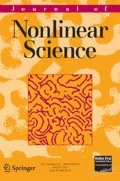Summary
We develop methods for determining local Lyapunov exponents from observations of a scalar data set. Using average mutual information and the method of false neighbors, we reconstruct a multivariate time series, and then use local polynomial neighborhood-to-neighborhood maps to determine the phase space partial derivatives required to compute Lyapunov exponents. In several examples we demonstrate that the methods allow one to accurately reproduce results determined when the dynamics is known beforehand. We present a new recursive QR decomposition method for finding the eigenvalues of products of matrices when that product is severely ill conditioned, and we give an argument to show that local Lyapunov exponents are ambiguous up to order 1/L in the number of steps due to the choice of coordinate system. Local Lyapunov exponents are the critical element in determining the practical predictability of a chaotic system, so the results here will be of some general use.
Similar content being viewed by others
References
Eckmann, J.-P., and D. Ruelle, “Ergodic Theory of Chaos and Strange Attractors,”Rev. Mod. Phys. 57, 617 (1985).
Abarbanel, H. D. I., R. Brown, and M. B. Kennel, “Variation of Lyapunov Exponents on a Strange Attractor,”Journal of Nonlinear Science,1, 175–199 (1991).
Brown, R., P. Bryant, and H. D. I. Abarbanel, “Computing the Lyapunov Spectrum of a Dynamical System from Observed Time Series,”Phys. Rev. A 43, 2787 (1991). An earlier paper with many of the main results is inPhys. Rev. Lett 65, 1523 (1990).
Maãné, R., “On the Dimension of the Compact Invariant Sets of Certain Nonlinear Maps,” inDynamical Systems and Turbulence, Warwick 1980, eds. D. Rand and L. S. Young,Lecture Notes in Mathematics 898, 230 Berlin: Springer, (1981).
Takens, E., “Detecting Strange Attractors in Turbulence,” inDynamical Systems and Turbulence, Warwick 1980, eds. D. Rand and L. S. Young,Lecture Notes in Mathematics 898, 366 Berlin: Springer, (1981).
Parlitz, U.,Int. J. of Bif. Chaos,2, 155–165 (1992).
Abarbanel, H. D. I., and M. M. Sushchik, “True Local Lyapunov Exponents and Models of Chaotic Systems Based on Observations,” to be submitted toJournal of Nonlinear Science, May 1992.
Fraser, A. M., and H. L. Swinney,Phys. Rev.,33A, 134 (1986); Fraser, A. M.,IEEE Trans, on Info. Theory 35, 245 (1989); Fraser, A. M.,Physica 34D, 391 (1989).
Abarbanel, H. D. L., R. Brown, and M. B. Kennel, “Lyapunov Exponents in Chaotic Systems: Their Importance and Their Evaluation Using Observed Data,”Int. Journal Mod. Phys. B5, 1347–1375 (1991).
Kennel, Matthew, B., R. Brown, and H. D. I. Abarbanel, “Determining Minimum Embedding Dimension Using a Geometrical Construction.,”Phys. Rev. A,45, 3403–3411 (1992).
Oseledec, V. I., “A Multiplicative Ergodic Theorem. Lyapunov Characteristic Numbers for Dynamical Systems,”Trudy Mosk. Mat. Obsc. 19, 197 (1968);Moscow Math. Soc. 19, 197 (1968).
Eckmann, J. -P., S. O. Kamphorst, D. Ruelle, and S. Ciliberto, “Lyapunov Exponents from Time Series,”Phys. Rev. A34, 4971 (1986).
[13]Sano, M., and Y. Sawada, “Measurement of Lyapunov Spectrum from a Chaotic Time Series,”Phys. Rev. Lett. 55, 1082 (1985). This paper also introduces the local-phase space method for finding DF(y(n)), but uses only local linear maps for this purpose. The method is unable to determine all exponents, just the largest exponent. The comparison between this method and the one used here is discussed in [9].
Ford, J. R., and W. R. Borland, “Common Los Alamos Mathematical Software Compendium,” Document Number CIC # 148 (April 1988), Los Alamos National Laboratory, Los Alamos, New Mexico.
Stoer, J., and R. Burlisch,Introduction to Numerical Analysis, Springer-Verlag, New York. (1980).
[16]Landa, P. S., and M. Rozenblum, “Time Series Analysis for System Identification and Diagnostics,”Physica D 48, 232–254 (1991).
Lorenz, E. N., “Deterministic Nonperiodic Flow,”J. Atmos. Sci. 20, 130 (1963).
Henon, M., “A Two-Dimensional Mapping with a Strange Attractor,”Commun. Math. Phys. 50, 69 (1976).
Ikeda, K., “Multiple-Valued Stationary State and Its Instability of the Transmitted Light by a Ring Cavity System,”Opt. Commun. 30, 257 (1979).
[20]Ellner, S., A. R. Gallant, D. F. McGaffrey, and D. Nychka, “Convergence Rates and Data Requirements for Jacobian-based Estimates of Lyapunov Exponents from Data,”Phys. Lett. A,153, 357–363 (1991).
McGaffrey, D. F., S. Ellner, A. R. Gallant, and D. W. Nychka, “Estimating the Lyapunov Exponent of a Chaotic System with Nonparametric Regression,”Journal of the American Statistical Association, to appear.
Author information
Authors and Affiliations
Additional information
Communicated by Yasuji Sawada
Rights and permissions
About this article
Cite this article
Abarbanel, H.D.I., Brown, R. & Kennel, M.B. Local Lyapunov exponents computed from observed data. J Nonlinear Sci 2, 343–365 (1992). https://doi.org/10.1007/BF01208929
Received:
Accepted:
Issue Date:
DOI: https://doi.org/10.1007/BF01208929




